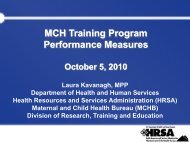(STROBE) Statement
(STROBE) Statement
(STROBE) Statement
Create successful ePaper yourself
Turn your PDF publications into a flip-book with our unique Google optimized e-Paper software.
<strong>STROBE</strong> INITIATIVE<br />
The Strengthening the Reporting of Observational Studies<br />
in Epidemiology (<strong>STROBE</strong>) <strong>Statement</strong><br />
Guidelines for Reporting Observational Studies<br />
Erik von Elm,* Douglas G. Altman,† Matthias Egger,*‡ Stuart J. Pocock,§ Peter C. Gøtzsche, and<br />
Jan P. Vandenbroucke for the <strong>STROBE</strong> Initiative<br />
Abstract: Much biomedical research is observational. The reporting<br />
of such research is often inadequate, which hampers the assessment<br />
of its strengths and weaknesses and of a study’s generalizability. The<br />
Strengthening the Reporting of Observational Studies in Epidemiology<br />
(<strong>STROBE</strong>) Initiative developed recommendations on what<br />
should be included in an accurate and complete report of an<br />
observational study. We defined the scope of the recommendations<br />
to cover three main study designs: cohort, case-control and crosssectional<br />
studies. We convened a 2-day workshop in September<br />
2004, with methodologists, researchers, and journal editors to draft<br />
a checklist of items. This list was subsequently revised during<br />
several meetings of the coordinating group and in e-mail discussions<br />
with the larger group of <strong>STROBE</strong> contributors, taking into account<br />
empirical evidence and methodological considerations. The workshop<br />
and the subsequent iterative process of consultation and revision<br />
resulted in a checklist of 22 items (the <strong>STROBE</strong> <strong>Statement</strong>) that<br />
relate to the title, abstract, introduction, methods, results, and discussion<br />
sections of articles. 18 items are common to all three study<br />
designs and four are specific for cohort, case-control, or crosssectional<br />
studies. A detailed Explanation and Elaboration document<br />
is published separately and is freely available on the web sites of<br />
The workshop was funded by the European Science Foundation (ESF).<br />
Additional funding was received from the Medical Research Council<br />
Research and Development Programme and the Medical Research Council<br />
Health Services Research Collaboration and the National Health<br />
Services Research & Development Methodology Programme.<br />
Editors’ note: In order to encourage dissemination of the <strong>STROBE</strong> <strong>Statement</strong>,<br />
this article is freely accessible on the Web site of EPIDEMIOLOGY<br />
(www.epidem.com) and will also be published in Annals of Internal<br />
Medicine, BMJ, Bulletin of the World Health Organization, The Lancet,<br />
PLoS Medicine, and Preventive Medicine. The authors jointly hold the<br />
copyright of this article. For details on further use, see the <strong>STROBE</strong><br />
website (www.strobe-statement.org). Related articles appear on pages<br />
789, 791, 792, 794, 797, and 805.<br />
From the *Institute of Social and Preventive Medicine (ISPM), University<br />
of Bern, Bern, Switzerland; †Centre for Statistics in Medicine, University<br />
of Oxford, Oxford UK; ‡Department of Social Medicine, University of<br />
Bristol, Bristol, UK; §London School of Hygiene and Tropical Medicine,<br />
University of London, London, UK; Nordic Cochrane Centre, Copenhagen,<br />
Denmark; and Department of Clinical Epidemiology, Leiden<br />
University Hospital, Leiden, Netherlands.<br />
Correspondence: Erik von Elm, Institute of Social and Preventive Medicine<br />
(ISPM), University of Bern, Finkenhubelweg 11, CH-3012 Bern, Switzerland.<br />
E-mail: strobe@ispm.unibe.ch.<br />
Copyright © 2007 by the authors<br />
ISSN: 1044-3983/07/1806-0800<br />
DOI: 10.1097/EDE.0b013e3181577654<br />
800<br />
PLoS Medicine, Annals of Internal Medicine, and EPIDEMIOLOGY.<br />
We hope that the <strong>STROBE</strong> <strong>Statement</strong> will contribute to improving<br />
the quality of reporting of observational studies.<br />
(Epidemiology 2007;18: 800–804)<br />
Many questions in medical research are investigated in<br />
observational studies. 1 Much of the research into the<br />
cause of diseases relies on cohort, case-control, or crosssectional<br />
studies. Observational studies also have a role in<br />
research into the benefits and harms of medical interventions.<br />
2 Randomized trials cannot answer all important questions<br />
about a given intervention. For example, observational<br />
studies are more suitable to detect rare or late adverse effects<br />
of treatments, and are more likely to provide an indication of<br />
what is achieved in daily medical practice. 3<br />
Research should be reported transparently so that readers<br />
can follow what was planned, what was done, what was<br />
found, and what conclusions were drawn. The credibility of<br />
research depends on a critical assessment by others of the<br />
strengths and weaknesses in study design, conduct, and analysis.<br />
Transparent reporting is also needed to judge whether<br />
and how results can be included in systematic reviews. 4,5<br />
However, in published observational research important information<br />
is often missing or unclear. An analysis of epidemiological<br />
studies published in general medical and specialist<br />
journals found that the rationale behind the choice of potential<br />
confounding variables was often not reported. 6 Only few<br />
reports of case-control studies in psychiatry explained the<br />
methods used to identify cases and controls. 7 In a survey of<br />
longitudinal studies in stroke research, 17 of 49 articles<br />
(35%) did not specify the eligibility criteria. 8 Others have<br />
argued that without sufficient clarity of reporting, the benefits<br />
of research might be achieved more slowly, 9 and that there is<br />
a need for guidance in reporting observational studies. 10,11<br />
Recommendations on the reporting of research can<br />
improve reporting quality. The Consolidated Standards of<br />
Reporting Trials (CONSORT) <strong>Statement</strong> was developed in<br />
1996 and revised 5 years later. 12 Many medical journals<br />
supported this initiative, 13 which has helped to improve the<br />
Epidemiology Volume 18, Number 6, November 2007
Epidemiology Volume 18, Number 6, November 2007 <strong>STROBE</strong> Initiative for Reporting Observational Studies<br />
quality of reports of randomized trials. 14,15 Similar initiatives<br />
have followed for other research areas—eg, for the reporting<br />
of meta-analyses of randomized trials 16 or diagnostic studies.<br />
17 We established a network of methodologists, researchers,<br />
and journal editors to develop recommendations for the<br />
reporting of observational research: the Strengthening the<br />
Reporting of Observational Studies in Epidemiology<br />
(<strong>STROBE</strong>) <strong>Statement</strong>.<br />
Aims and Use of the <strong>STROBE</strong> <strong>Statement</strong><br />
The <strong>STROBE</strong> <strong>Statement</strong> is a checklist of items that<br />
should be addressed in articles reporting on the 3 main study<br />
designs of analytical epidemiology: cohort, case-control, and<br />
cross-sectional studies. The intention is solely to provide<br />
guidance on how to report observational research well: these<br />
recommendations are not prescriptions for designing or conducting<br />
studies. Also, while clarity of reporting is a prerequisite<br />
to evaluation, the checklist is not an instrument to<br />
evaluate the quality of observational research.<br />
Here we present the <strong>STROBE</strong> <strong>Statement</strong> and explain<br />
how it was developed. In a detailed companion paper, the<br />
Explanation and Elaboration article, 18–20 we justify the<br />
inclusion of the different checklist items and give methodological<br />
background and published examples of what we<br />
consider transparent reporting. We strongly recommend<br />
using the <strong>STROBE</strong> checklist in conjunction with the explanatory<br />
article, which is available freely on the websites of PLoS<br />
Medicine (www.plosmedicine.org), Annals of Internal Medicine<br />
(www.annals.org), and EPIDEMIOLOGY (www.epidem.com).<br />
Development of the <strong>STROBE</strong> <strong>Statement</strong><br />
We established the <strong>STROBE</strong> Initiative in 2004, obtained<br />
funding for a workshop and set up a website<br />
(www.strobe-statement.org). We searched textbooks, bibliographic<br />
databases, reference lists, and personal files for<br />
relevant material, including previous recommendations,<br />
empirical studies of reporting and articles describing relevant<br />
methodological research. Because observational research<br />
makes use of many different study designs, we felt<br />
that the scope of <strong>STROBE</strong> had to be clearly defined early<br />
on. We decided to focus on the 3 study designs that are<br />
used most widely in analytical observational research:<br />
cohort, case-control, and cross-sectional studies.<br />
We organized a 2-day workshop in Bristol, UK, in<br />
September 2004. 23 individuals attended this meeting, including<br />
editorial staff from Annals of Internal Medicine,<br />
BMJ, Bulletin of the World Health Organization, International<br />
Journal of Epidemiology, JAMA, Preventive Medicine,<br />
and The Lancet, as well as epidemiologists, methodologists,<br />
statisticians, and practitioners from Europe and North America.<br />
Written contributions were sought from 10 other individuals<br />
who declared an interest in contributing to <strong>STROBE</strong>, but<br />
could not attend. Three working groups identified items<br />
deemed to be important to include in checklists for each type<br />
of study. A provisional list of items prepared in advance<br />
(available from our website) was used to facilitate discussions.<br />
The 3 draft checklists were then discussed by all<br />
participants and, where possible, items were revised to make<br />
them applicable to all three study designs. In a final plenary<br />
session, the group decided on the strategy for finalizing and<br />
disseminating the <strong>STROBE</strong> statement.<br />
After the workshop we drafted a combined checklist<br />
including all three designs and made it available on our<br />
website. We invited participants and additional scientists and<br />
editors to comment on this draft checklist. We subsequently<br />
published 3 revisions on the website, and 2 summaries of<br />
comments received and changes made. During this process<br />
the coordinating group (ie, the authors of the present paper)<br />
met on eight occasions for 1 or 2 days and held several<br />
telephone conferences to revise the checklist and to prepare<br />
the present paper and the Explanation and Elaboration<br />
paper. 18–20 The coordinating group invited 3 additional coauthors<br />
with methodological and editorial expertise to help<br />
write the Explanation and Elaboration paper, and sought<br />
feedback from more than 30 people, who are listed at the end<br />
of this paper. We allowed several weeks for comments on<br />
subsequent drafts of the paper and reminded collaborators<br />
about deadlines by e-mail.<br />
<strong>STROBE</strong> Components<br />
The <strong>STROBE</strong> statement is a checklist of 22 items that<br />
we consider essential for good reporting of observational<br />
studies (Table 1). These items relate to the article’s title and<br />
abstract (item 1), the introduction (items 2 and 3), methods<br />
(items 4–12), results (items 13–17), and discussion sections<br />
(items 18–21) and other information (item 22 on funding). 18<br />
items are common to all three designs, while four (items 6,<br />
12, 14, and 15) are design-specific, with different versions for<br />
all or part of the item. For some items (indicated by asterisks),<br />
information should be given separately for cases and controls<br />
in case-control studies, or exposed and unexposed groups in<br />
cohort and cross-sectional studies. Although presented here<br />
as a single checklist, separate checklists are available for each<br />
of the 3 study designs on the <strong>STROBE</strong> website.<br />
Implications and Limitations<br />
The <strong>STROBE</strong> statement was developed to assist authors<br />
when writing up analytical observational studies, to<br />
support editors and reviewers when considering such articles<br />
for publication, and to help readers when critically appraising<br />
published articles. We developed the checklist through an<br />
open process, taking into account the experience gained with<br />
previous initiatives, in particular CONSORT. We reviewed<br />
the relevant empirical evidence as well as methodological<br />
work, and subjected consecutive drafts to an extensive iterative<br />
process of consultation. The checklist presented here is<br />
thus based on input from a large number of individuals with<br />
diverse backgrounds and perspectives. The comprehensive<br />
© 2007 the authors 801
von Elm et al Epidemiology Volume 18, Number 6, November 2007<br />
TABLE 1. The <strong>STROBE</strong> statement—Checklist of Items That Should be Addressed in Reports of Observational Studies<br />
Item<br />
Number Recommendation<br />
TITLE and<br />
1 (a) Indicate the study’s design with a commonly used term in the title or the abstract<br />
ABSTRACT<br />
INTRODUCTION<br />
(b) Provide in the abstract an informative and balanced summary of what was done and what was found<br />
Background/<br />
rationale<br />
2 Explain the scientific background and rationale for the investigation being reported<br />
Objectives<br />
METHODS<br />
3 State specific objectives, including any prespecified hypotheses<br />
Study design 4 Present key elements of study design early in the paper<br />
Setting 5 Describe the setting, locations, and relevant dates, including periods of recruitment, exposure, follow-up, and data collection<br />
Participants 6 (a) Cohort study—Give the eligibility criteria, and the sources and methods of selection of participants. Describe methods of<br />
follow-up<br />
Case-control study—Give the eligibility criteria, and the sources and methods of case ascertainment and control selection. Give<br />
the rationale for the choice of cases and controls<br />
Cross-sectional study—Give the eligibility criteria, and the sources and methods of selection of participants<br />
(b) Cohort study—For matched studies, give matching criteria and number of exposed and unexposed<br />
Case-control study—For matched studies, give matching criteria and the number of controls per case<br />
Variables 7 Clearly define all outcomes, exposures, predictors, potential confounders, and effect modifiers. Give diagnostic criteria, if applicable<br />
Data sources/ 8* For each variable of interest, give sources of data and details of methods of assessment (measurement). Describe comparability of<br />
measurement<br />
assessment methods if there is more than one group<br />
Bias 9 Describe any efforts to address potential sources of bias<br />
Study size 10 Explain how the study size was arrived at<br />
Quantitative<br />
variables<br />
11 Explain how quantitative variables were handled in the analyses. If applicable, describe which groupings were chosen, and why<br />
Statistical<br />
12 (a) Describe all statistical methods, including those used to control for confounding<br />
methods<br />
RESULTS<br />
(b) Describe any methods used to examine subgroups and interactions<br />
(c) Explain how missing data were addressed<br />
(d) Cohort study—If applicable, explain how loss to follow-up was addressed<br />
Case-control study—If applicable, explain how matching of cases and controls was addressed<br />
Cross-sectional study—If applicable, describe analytical methods taking account of sampling strategy<br />
(e) Describe any sensitivity analyses<br />
Participants 13* (a) Report the numbers of individuals at each stage of the study—eg, numbers potentially eligible, examined for eligibility,<br />
confirmed eligible, included in the study, completing follow-up, and analyzed<br />
(b) Give reasons for non-participation at each stage<br />
(c) Consider use of a flow diagram<br />
Descriptive data 14* (a) Give characteristics of study participants (eg, demographic, clinical, social) and information on exposures and potential<br />
confounders<br />
(b) Indicate the number of participants with missing data for each variable of interest<br />
(c) Cohort study—Summarize follow-up time (eg, average and total amount)<br />
Outcome data 15* Cohort study—Report numbers of outcome events or summary measures over time<br />
Case-control study—Report numbers in each exposure category, or summary measures of exposure<br />
Cross-sectional study—Report numbers of outcome events or summary measures<br />
Main results 16 (a) Give unadjusted estimates and, if applicable, confounder-adjusted estimates and their precision (eg, 95% confidence intervals).<br />
Make clear which confounders were adjusted for and why they were included<br />
(b) Report category boundaries when continuous variables were categorised<br />
(c) If relevant, consider translating estimates of relative risk into absolute risk for a meaningful time period<br />
Other analyses<br />
DISCUSSION<br />
17 Report other analyses done—eg, analyses of subgroups and interactions, and sensitivity analyses<br />
Key results 18 Summarise key results with reference to study objectives<br />
Limitations 19 Discuss limitations of the study, taking into account sources of potential bias or imprecision. Discuss both direction and magnitude<br />
of any potential bias<br />
Interpretation 20 Give a cautious overall interpretation of results considering objectives, limitations, multiplicity of analyses, results from similar<br />
studies, and other relevant evidence<br />
Generalizability<br />
OTHER<br />
INFORMATION<br />
21 Discuss the generalizability (external validity) of the study results<br />
Funding 22 Give the source of funding and the role of the funders for the present study and, if applicable, for the original study on which the<br />
present article is based<br />
*Give such information separately for cases and controls in case-control studies, and, if applicable, for exposed and unexposed groups in cohort and cross-sectional studies.<br />
An explanation and elaboration article discusses each checklist item and gives methodological background and published examples of transparent reporting. The <strong>STROBE</strong><br />
checklist is best used in conjunction with this article (freely available on the websites of PLoS Medicine, Annals of Internal Medicine, and EPIDEMIOLOGY). Separate versions of the<br />
checklist for cohort, case-control, and cross-sectional studies are available on the <strong>STROBE</strong> website.<br />
802<br />
© 2007 the authors
Epidemiology Volume 18, Number 6, November 2007 <strong>STROBE</strong> Initiative for Reporting Observational Studies<br />
explanatory article, 18–20 which is intended for use alongside<br />
the checklist, also benefited greatly from this consultation<br />
process.<br />
Observational studies serve a wide range of purposes,<br />
on a continuum from the discovery of new findings to the<br />
confirmation or refutation of previous findings. 18–20 Some<br />
studies are essentially exploratory and raise interesting hypotheses.<br />
Others pursue clearly defined hypotheses in available<br />
data. In yet another type of studies, the collection of new<br />
data is planned carefully on the basis of an existing hypothesis.<br />
We believe the present checklist can be useful for all<br />
these studies, since the readers always need to know what<br />
was planned (and what was not), what was done, what was<br />
found, and what the results mean. We acknowledge that<br />
<strong>STROBE</strong> is currently limited to 3 main observational study<br />
designs. We would welcome extensions that adapt the checklist<br />
to other designs—eg, case-crossover studies or ecological<br />
studies—and also to specific topic areas. Four extensions are<br />
now available for the CONSORT statement. 21–24 A first<br />
extension to <strong>STROBE</strong> is underway for gene-disease association<br />
studies: the <strong>STROBE</strong> Extension to Genetic Association<br />
studies (STREGA) Initiative. 25 We ask those who aim to<br />
develop extensions of the <strong>STROBE</strong> <strong>Statement</strong> to contact the<br />
coordinating group first to avoid duplication of effort.<br />
The <strong>STROBE</strong> <strong>Statement</strong> should not be interpreted as an<br />
attempt to prescribe the reporting of observational research in a<br />
rigid format. The checklist items should be addressed in sufficient<br />
detail and with clarity somewhere in an article, but the<br />
order and format for presenting information depends on author<br />
preferences, journal style, and the traditions of the research field.<br />
For instance, we discuss the reporting of results under a number<br />
of separate items, while recognizing that authors might<br />
address several items within a single section of text or in<br />
a table. Also, item 22, on the source of funding and the role<br />
of funders, could be addressed in an appendix or in the<br />
methods section of the article. We do not aim at standardizing<br />
reporting. Authors of randomized clinical trials were<br />
asked by an editor of a specialist medical journal to<br />
“CONSORT” their manuscripts on submission. 26 We believe<br />
that manuscripts should not be “<strong>STROBE</strong>d”, in the<br />
sense of regulating style or terminology. We encourage<br />
authors to use narrative elements, including the description<br />
of illustrative cases, to complement the essential information<br />
about their study, and to make their articles an<br />
interesting read. 27<br />
We emphasize that the <strong>STROBE</strong> <strong>Statement</strong> was not<br />
developed as a tool for assessing the quality of published<br />
observational research. Such instruments have been developed<br />
by other groups and were the subject of a recent<br />
systematic review. 28 In the Explanation and Elaboration paper,<br />
we used several examples of good reporting from studies<br />
whose results were not confirmed in further research - the<br />
important feature was the good reporting, not whether the<br />
research was of good quality. However, if <strong>STROBE</strong> is<br />
adopted by authors and journals, issues such as confounding,<br />
bias, and generalizability could become more transparent,<br />
which might help temper the over-enthusiastic reporting of<br />
new findings in the scientific community and popular media,<br />
29 and improve the methodology of studies in the long<br />
term. Better reporting may also help to have more informed<br />
decisions about when new studies are needed, and what they<br />
should address.<br />
We did not undertake a comprehensive systematic review<br />
for each of the checklist items and subitems nor did we do our<br />
own research to fill gaps in the evidence base. Further, although<br />
no one was excluded from the process, the composition of the<br />
group of contributors was influenced by existing networks and<br />
was not representative in terms of geography (it was dominated<br />
by contributors from Europe and North America) and was<br />
probably not representative in terms of research interests and<br />
disciplines. We stress that <strong>STROBE</strong> and other recommendations<br />
on the reporting of research should be seen as<br />
evolving documents that require continual assessment,<br />
refinement, and, if necessary, change. We welcome suggestions<br />
for the further dissemination of <strong>STROBE</strong>—eg, by<br />
republication of the present article in specialist journals<br />
and in journals published in other languages. Groups or<br />
individuals who intend to translate the checklist to other<br />
languages should consult the coordinating group beforehand.<br />
We will revise the checklist in the future, taking into<br />
account comments, criticism, new evidence, and experience<br />
from its use. We invite readers to submit their<br />
comments via the <strong>STROBE</strong> website (www.strobe-statement.org).<br />
ACKNOWLEDGMENTS<br />
We are grateful to Gerd Antes, Kay Dickersin, Shah<br />
Ebrahim, and Richard Lilford for supporting the <strong>STROBE</strong><br />
initiative. We are grateful to the following institutions that<br />
have hosted working meetings of the coordinating group:<br />
Institute of Social and Preventive Medicine (ISPM), University<br />
of Bern, Bern, Switzerland; Department of Social Medicine,<br />
University of Bristol, Bristol, UK; London School of<br />
Hygiene and Tropical Medicine, London, UK; Nordic Cochrane<br />
Centre, Copenhagen, Denmark; and Centre for Statistics<br />
in Medicine, Oxford, UK. We are grateful to 6 reviewers<br />
who provided helpful comments on a previous draft of this<br />
paper. The following individuals have contributed to the<br />
content and elaboration of the <strong>STROBE</strong> statement: Douglas<br />
G Altman, Maria Blettner, Paolo Boffetta, Hermann Brenner,<br />
Geneviève Chêne, Cyrus Cooper, George Davey-Smith, Erik<br />
von Elm, Matthias Egger, France Gagnon, Peter C.<br />
Gøtzsche, Philip Greenland, Sander Greenland, Claire Infante-Rivard,<br />
John Ioannidis, Astrid James, Giselle Jones,<br />
Bruno Ledergerber, Julian Little, Margaret May, David Moher,<br />
Hooman Momen, Alfredo Morabia, Hal Morgenstern,<br />
Cynthia D. Mulrow, Fred Paccaud, Stuart J. Pocock, Charles<br />
© 2007 the authors 803
von Elm et al Epidemiology Volume 18, Number 6, November 2007<br />
Poole, Martin Röösli, Dietrich Rothenbacher, Kenneth Rothman,<br />
Caroline Sabin, Willi Sauerbrei, Lale Say, James J.<br />
Schlesselman, Jonathan Sterne, Holly Syddall, Jan P. Vandenbroucke,<br />
Ian White, Susan Wieland, Hywel Williams,<br />
Guang Yong Zou.<br />
REFERENCES<br />
1. Glasziou P, Vandenbroucke JP, Chalmers I. Assessing the quality of<br />
research. BMJ. 2004;328:39–41.<br />
2. Black N. Why we need observational studies to evaluate the effectiveness<br />
of health care. BMJ. 1996;312:1215–1218.<br />
3. Papanikolaou PN, Christidi GD, Ioannidis JP. Comparison of evidence<br />
on harms of medical interventions in randomized and nonrandomized<br />
studies. CMAJ. 2006;174:635–641.<br />
4. Jüni P, Altman DG, Egger M. Systematic reviews in health care:<br />
Assessing the quality of controlled clinical trials. BMJ. 2001;323:42–46.<br />
5. Egger M, Schneider M, Davey Smith G. Spurious precision? Metaanalysis<br />
of observational studies. BMJ. 1998;316:140–144.<br />
6. Pocock SJ, Collier TJ, Dandreo KJ, et al. Issues in the reporting of<br />
epidemiological studies: a survey of recent practice. BMJ. 2004;329:883.<br />
7. Lee W, Bindman J, Ford T, et al. Bias in psychiatric case-control studies:<br />
literature survey. Br J Psychiatry. 2007;190:204–209.<br />
8. Tooth L, Ware R, Bain C, et al. Quality of reporting of observational<br />
longitudinal research. Am J Epidemiol. 2005;161:280–288.<br />
9. Bogardus ST Jr., Concato J, Feinstein AR. Clinical epidemiological<br />
quality in molecular genetic research: the need for methodological<br />
standards. JAMA. 1999;281:1919–1926.<br />
10. Anonymous. Guidelines for documentation of epidemiologic studies.<br />
Epidemiology Work Group of the Interagency Regulatory Liaison<br />
Group. Am J Epidemiol. 1981;114:609–613.<br />
11. Rennie D. CONSORT revised - improving the reporting of randomized<br />
trials. JAMA. 2001;285:2006–2007.<br />
12. Moher D, Schulz KF, Altman DG. The CONSORT statement: revised<br />
recommendations for improving the quality of reports of parallel-group<br />
randomised trials. Lancet. 2001;357:1191–1194.<br />
13. Moher D, Altman DG, Schulz KF, et al. Opportunities and challenges<br />
for improving the quality of reporting clinical research: CONSORT and<br />
beyond. CMAJ. 2004;171:349–350.<br />
14. Plint AC, Moher D, Morrison A, et al. Does the CONSORT checklist<br />
improve the quality of reports of randomised controlled trials? A<br />
systematic review. Med J Aust. 2006;185:263–267.<br />
804<br />
15. Egger M, Juni P, Bartlett C. Value of flow diagrams in reports of<br />
randomized controlled trials. JAMA. 2001;285:1996–1999.<br />
16. Moher D, Cook DJ, Eastwood S, et al. Improving the quality of reports<br />
of meta-analyses of randomised controlled trials: the QUOROM statement.<br />
Quality of Reporting of Meta-analyses. Lancet. 1999;354:1896–<br />
1900.<br />
17. Bossuyt PM, Reitsma JB, Bruns DE, et al. Towards complete and<br />
accurate reporting of studies of diagnostic accuracy: The STARD<br />
Initiative. Ann Intern Med. 2003;138:40–44.<br />
18. Vandenbroucke JP, von Elm E, Altman DG, et al. Strengthening the<br />
Reporting of Observational Studies in Epidemiology (<strong>STROBE</strong>): explanation<br />
and elaboration. PLoS Medicine. 2007; in press.<br />
19. Vandenbroucke JP, von Elm E, Altman DG, et al. Strengthening the<br />
Reporting of Observational Studies in Epidemiology (<strong>STROBE</strong>): explanation<br />
and elaboration. Ann Intern Med. 2007; in press.<br />
20. Vandenbroucke JP, von Elm E, Altman DG, et al. Strengthening the<br />
Reporting of Observational Studies in Epidemiology (<strong>STROBE</strong>): explanation<br />
and elaboration. Epidemiology. 2007;18:805–835.<br />
21. Ioannidis JP, Evans SJ, Gotzsche PC, et al. Better reporting of harms in<br />
randomized trials: an extension of the CONSORT statement. Ann Intern<br />
Med. 2004;141:781–788.<br />
22. Campbell MK, Elbourne DR, Altman DG. CONSORT statement: extension<br />
to cluster randomised trials. BMJ. 2004;328:702–708.<br />
23. Piaggio G, Elbourne DR, Altman DG, et al. Reporting of noninferiority<br />
and equivalence randomized trials: an extension of the CONSORT<br />
statement. JAMA. 2006;295:1152–1160.<br />
24. Gagnier JJ, Boon H, Rochon P, et al. Reporting randomized, controlled<br />
trials of herbal interventions: an elaborated CONSORT statement. Ann<br />
Intern Med. 2006;144:364–367.<br />
25. Ioannidis JP, Gwinn M, Little J, et al. A road map for efficient and<br />
reliable human genome epidemiology. Nat Genet. 2006;38:3–5.<br />
26. Ormerod AD. CONSORT your submissions: an update for authors. Br J<br />
Dermatol. 2001;145:378–379.<br />
27. Schriger DL. Suggestions for improving the reporting of clinical research:<br />
the role of narrative. Ann Emerg Med. 2005;45:437–443.<br />
28. Sanderson S, Tatt ID, Higgins JP. Tools for assessing quality and<br />
susceptibility to bias in observational studies in epidemiology: a systematic<br />
review and annotated bibliography. Int J Epidemiol. 2007;<br />
36:666–676.<br />
29. Bartlett C, Sterne J, Egger M. What is newsworthy? Longitudinal study<br />
of the reporting of medical research in two British newspapers. BMJ.<br />
2002;325:81–84.<br />
© 2007 the authors




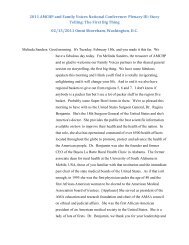


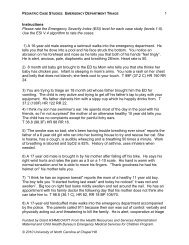
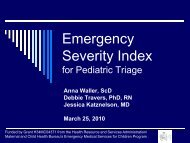
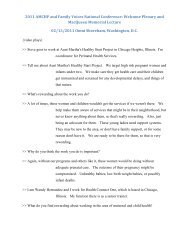
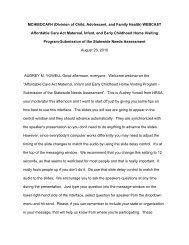
![Hormone Disruptors and Women's Health: Reasons for Concern [PDF]](https://img.yumpu.com/19410002/1/190x245/hormone-disruptors-and-womens-health-reasons-for-concern-pdf.jpg?quality=85)

